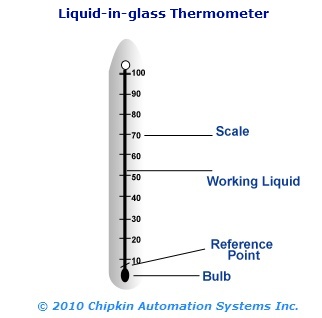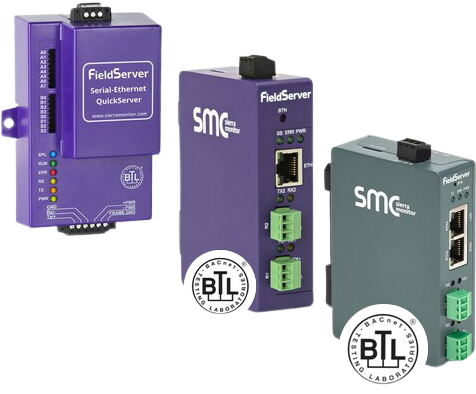Liquid-In-Glass Thermometers
A liquid-in-glass thermometer is the simplest and most commonly employed type of temperature measurement device. It is one of the oldest thermometers available in the industry. It gives fairly accurate results within the temperature range of -200 to 600°C. No special means are needed to measure temperature via these thermometers. One can read temperature readings easily with human eyes. They find their use in a variety of applications such as medicine, metrology, and industry. The foremost liquid-in-glass thermometer was introduced in the year 1650 in which the liquid-filled in was a spirit from wine. Later on, more linear thermometers were developed with the use of mercury as a liquid inside the thermometer.
"In the LIG thermometer, the thermally sensitive element is a liquid contained in a graduated glass envelope. The principle used to measure temperature is that of the apparent thermal expansion of the liquid. It is the difference between the volumetric reversible thermal expansion of the liquid and its glass container that makes it possible to measure temperature."
Construction
A typical liquid-in-glass thermometer is shown in the figure below.

It mainly comprises:
- A bulb which acts as a container for the functioning liquid where it can easily expand or contract in capacity.
- A stem, "a glass tube containing a tiny capillary connected to the bulb and enlarged at the bottom into a bulb that is partially filled with a working liquid".
- A temperature scale which is basically preset or imprinted on the stem for displaying temperature readings.
- Point of reference i.e. a calibration point which is most commonly the ice point.
- A working liquid is generally either mercury or alcohol.
- An inert gas, mainly argon or nitrogen which is filled inside the thermometer above mercury to trim down its volatilization.
Main Features
Key features of liquid-in-glass thermometers include:
- The extent to which these thermometers are inserted into the medium under temperature measurement principally decides the accuracy of results. Typically, three classes of immersion exist which are total, partial and complete immersion classified according to the level of contact between the medium and the sensing element.
- "An error can be produced when the thermometer is not immersed to the same extent as it was when it was originally calibrated. An 'emergent stem correction' may be necessary when it is not possible to immerse the thermometer sufficiently deeply."
- The response time of a liquid-in-glass thermometer varies according to the kind of thermometer, its bulb volume, thickness, and overall weight. For getting a quick response, the bulb of the thermometer should be designed in such a way that it results in small and the bulb wall thin.
- Their sensitivity is based upon the reversible thermal expansion characteristics of the liquid in comparison to the glass. The more the thermal expansion of the liquid, the highly sensitive the thermometer is.
- Organic liquids which are usually employed for the construction of liquid-in-glass thermometers include toluene, ethyl alcohol and pentane. Although their thermal expansion is high they are non-linear and their use is restricted for high temperatures.
Applications
Liquid-in-glass thermometers are mainly employed in the Navy and Marine Corps in different configurations. They are also applied in meteorological and oceanographic applications, where they are generally calibrated by graduations eternally engraved into the glass.
Advantages
Following are the major advantages associated with the use of liquid-in-glass thermometers:
- They are comparatively cheaper than other temperature measurement devices.
- They are handy and convenient to use.
- Unlike electrical thermometers, they do not necessitate power supply or batteries for charging.
- They can be frequently applied in areas where there is problem of electricity.
- They provide very good repeatability and their calibration remains unaffected.
Limitations
Use of liquid-in-glass thermometers includes the following limitations too:
- They are considered inapt for applications involving extremely high or low temperatures.
- They can not be applied in regions where highly accurate results are desirable.
- As compared to electrical thermometers, they are very weak and delicate. Therefore, they must be handled with extra care because they are likely to break.
- Besides, they can not provide digital and automated results. Hence, their use is limited to areas where only manual reading is adequate, for example, a household thermometer.
- "Temperature readings should be noted immediately after removal because a glass thermometer can be affected by the environmental temperature, the heat produced by the hand holding it, cleaning, etc. This temperature should be recorded because a glass thermometer does not offer a recall of the measured temperature."
- Reading temperature via liquid-in-glass thermometers call for brilliant eyesight.
- Liquid elements contained in a glass thermometer may be perilous or risky to health owing to their potential chemical spills.
- These thermometers display temperatures either in Celsius or Fahrenheit scales. Thus, temperature conversion would be needed if the temperature reading is wanted in some other scale.
Did you know that we also do BACnet Integration Solutions?
Chipkin has BACnet solutions for almost every situation. We have over 20+ years of experience in BACnet integration, check out our BACnet Products:
